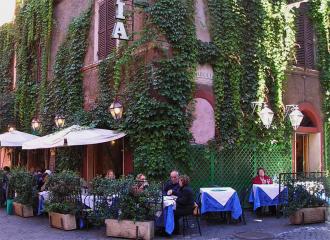When I first heard the phrase “fifth quarter meats,” I asked: What are fifth quarter meats, and how can you get five out of four? The answer to this latter question illuminates the history of Rome’s unique style of cooking. The first quarter of a butchered animal was given to the nobles, the second to the priests, the third to the rich, and the fourth to the army. The rest of the Romans were faced with the question: What do we eat? While it might not seem pleasant, the answer was offal and the other less-appreciated parts of an animal, which  are called “quinto quarto,” or fifth-quarter meats. Fifth-quarter meats comprise a quarter of an animal’s entire bulk and include parts of the animal that few Americans would ever think of eating. But, Rome does it with creativity and class. I decided to dive into this culinary smorgasbord head first, not by dining on testarelle (an entire roasted lamb or kid’s head) but on fried brains.
are called “quinto quarto,” or fifth-quarter meats. Fifth-quarter meats comprise a quarter of an animal’s entire bulk and include parts of the animal that few Americans would ever think of eating. But, Rome does it with creativity and class. I decided to dive into this culinary smorgasbord head first, not by dining on testarelle (an entire roasted lamb or kid’s head) but on fried brains.
There are restaurants in San Francisco that honor the fifth quarter, and that’s where I first heard the term. A16 and SPQR, two fantastic restaurants led by the culinary genius of Chef Nate Appleman; both focus on Italy’s Lazio region, in which Rome is located. On any given day you might find pajata (suckling kid or lamb intestines) or coda alla vaccinara (braised ox tails). Sweetbreads are also fifth-quarter meats.
 I tried the cervello fritto, aka fried brains, at Trattoria Da Luigi, located at Via del Corso 117 in Rome. The beauty of Roman cuisine, which includes highly prized cuts of meat, such as saltimbocca, alongside fifth-quarter offerings, is that it honors the whole animal. Having grown up vegetarian, this philosophy secured my respect more quickly than the appreciation of my taste buds. When the calf brains arrived, I was surprised to see that they looked like any other fried food; in fact, I could hardly tell the pieces of brain from the fried zucchini that rounded out the plate.
I tried the cervello fritto, aka fried brains, at Trattoria Da Luigi, located at Via del Corso 117 in Rome. The beauty of Roman cuisine, which includes highly prized cuts of meat, such as saltimbocca, alongside fifth-quarter offerings, is that it honors the whole animal. Having grown up vegetarian, this philosophy secured my respect more quickly than the appreciation of my taste buds. When the calf brains arrived, I was surprised to see that they looked like any other fried food; in fact, I could hardly tell the pieces of brain from the fried zucchini that rounded out the plate.
But I could tell the difference as soon as I took my first bite of brains. Simply put, brains taste like brains, mushy and bland. A friend said that they reminded him of barely cooked egg whites. The first bite was enough, and the second bite was more than enough. I would not be turning zombie any time soon. We asked the waiter if eating brains made you smarter, and he responded, “Certo”—of course.
 Perhaps the most famous Roman dish made with fifth-quarter meats is trippa all romana, which is served with tomato sauce. Tripe is the first or second stomach of a cow. It is a staple in many Italian homes. I ate it at one of my favorite restaurants in Rome, Alle Fratte di Trastevere , located at Via delle Fratte di Trastevere 49/50; I knew they would do it right, and I couldn’t pass up the opportunity. When the steaming bowl arrived, it was visually unappetizing. Served in a soup of half-disintegrated tomato, the tripe was sliced into white strips and otherwise featureless. One bite, again, was more than enough. It tasted slightly of seafood. When the waiter asked if everything was all right, I said yes, but that trippa is not for me. He responded, “Non é per mi anche”—It’s not for me either.
Perhaps the most famous Roman dish made with fifth-quarter meats is trippa all romana, which is served with tomato sauce. Tripe is the first or second stomach of a cow. It is a staple in many Italian homes. I ate it at one of my favorite restaurants in Rome, Alle Fratte di Trastevere , located at Via delle Fratte di Trastevere 49/50; I knew they would do it right, and I couldn’t pass up the opportunity. When the steaming bowl arrived, it was visually unappetizing. Served in a soup of half-disintegrated tomato, the tripe was sliced into white strips and otherwise featureless. One bite, again, was more than enough. It tasted slightly of seafood. When the waiter asked if everything was all right, I said yes, but that trippa is not for me. He responded, “Non é per mi anche”—It’s not for me either.
These two experiences have in no way turned me off to eating Rome’s fifth-quarter meats. These examples are the extreme of fifth-quarter cooking, and many dishes offer more subtle, highly seasoned versions; for example, coratella: lung, heart, and esophagus of lamb or kid, sautéed with artichokes.


Comments